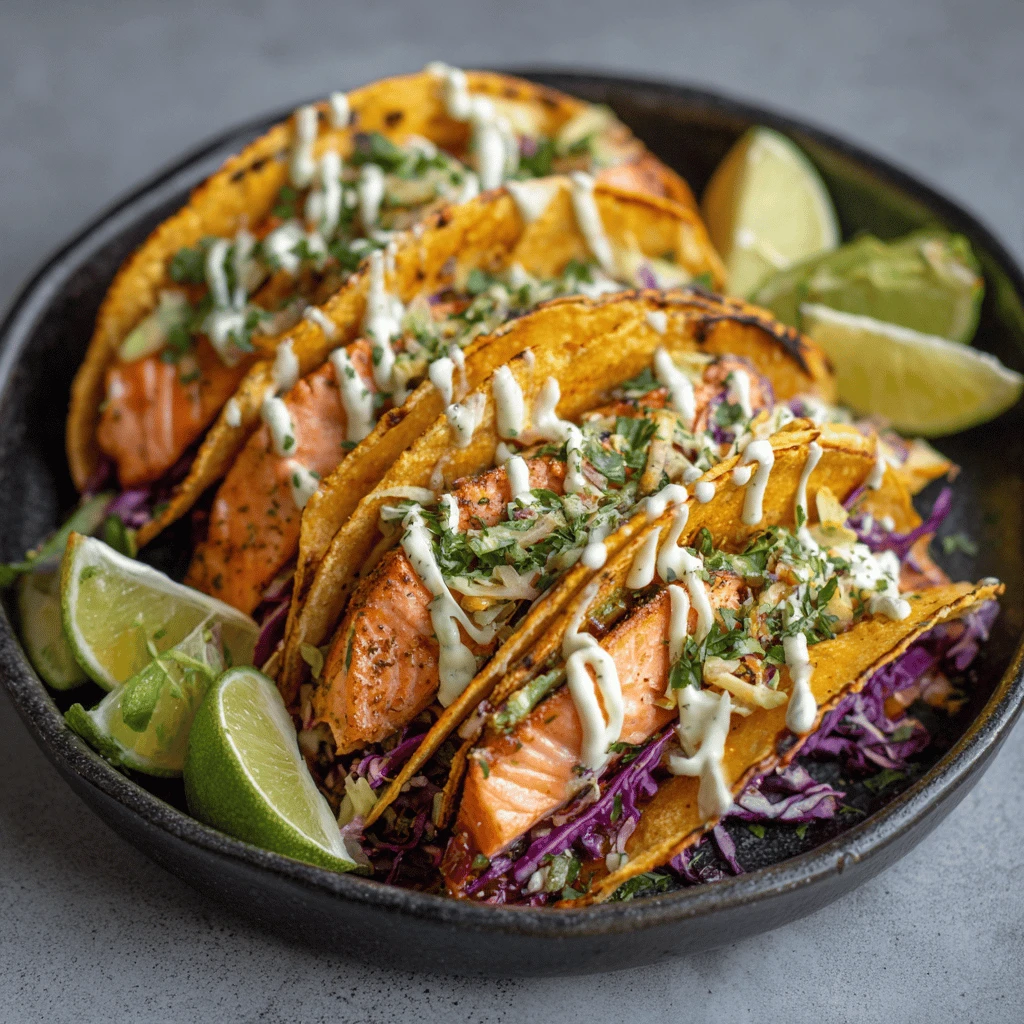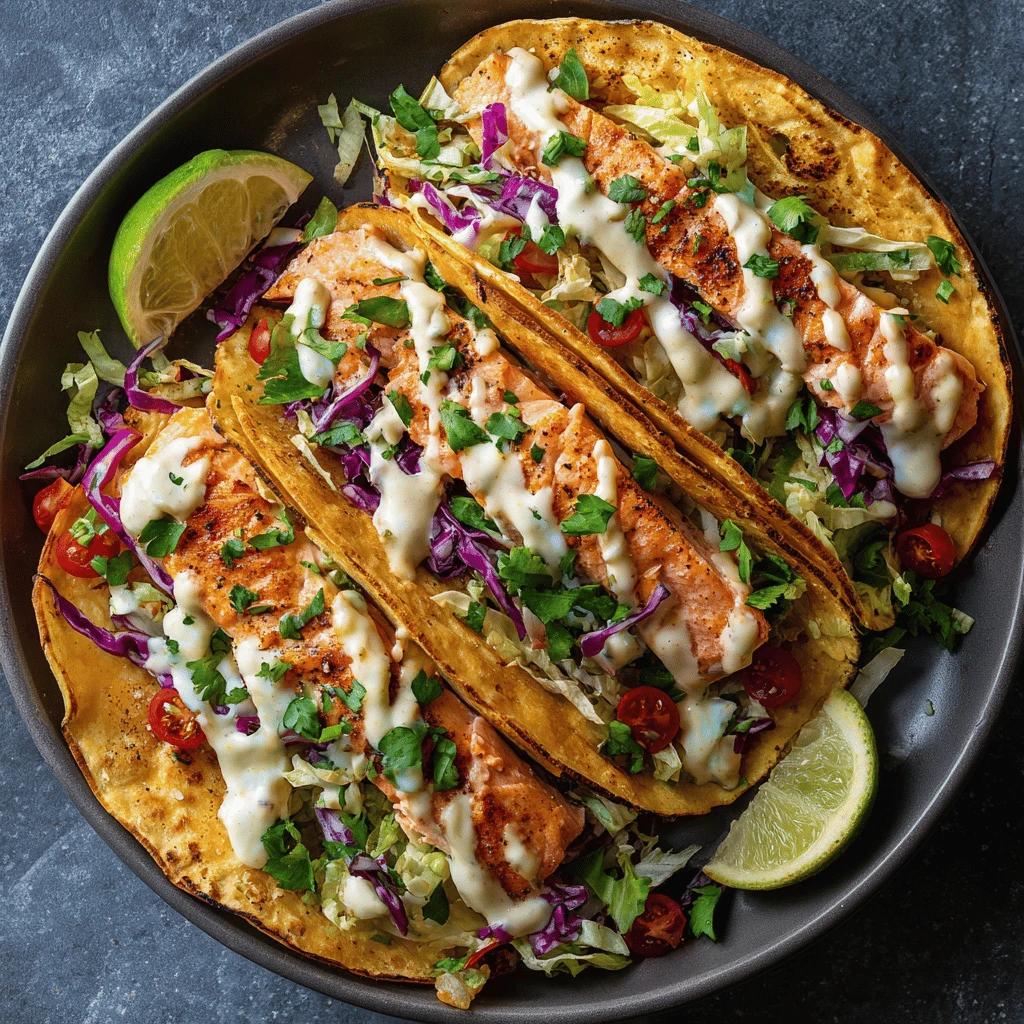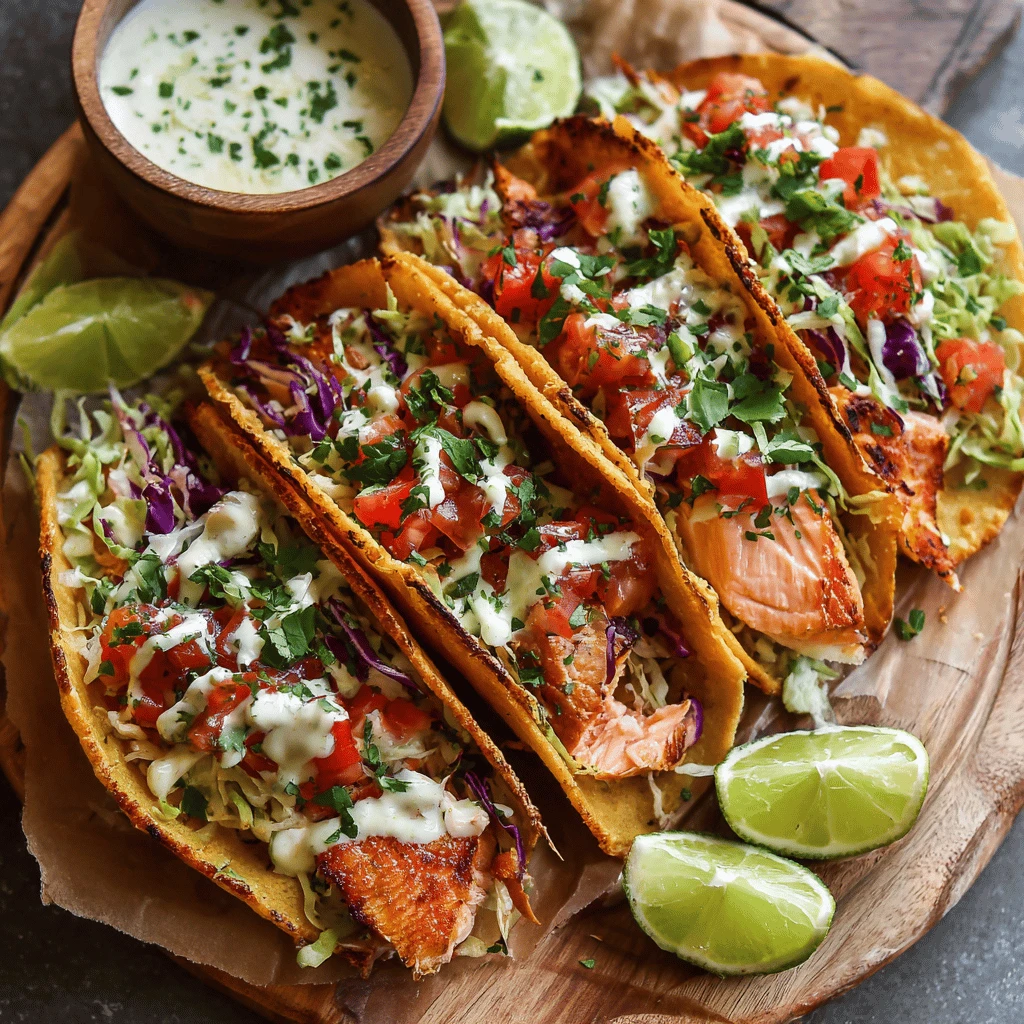High Protein Baked Salmon Tacos: A Healthy and Delicious Recipe
Introduction: Why Salmon Tacos are a Must-Try
Salmon tacos offer a fantastic combination of flavors, textures, and nutritional benefits. They are a delightful way to incorporate more seafood into your diet while enjoying a fun and customizable meal. Packed with protein, omega-3 fatty acids, and essential vitamins, salmon tacos are a healthy choice that doesn’t compromise on taste. This recipe focuses on baking the salmon, which is a simple and healthy cooking method that results in flaky, tender fish. Whether you’re looking for a quick weeknight dinner or a crowd-pleasing dish for entertaining, these high-protein baked salmon tacos are sure to be a hit.
Section 1: Preparing the Perfect Baked Salmon
The key to delicious salmon tacos is perfectly cooked salmon. Baking is a great method because it’s easy, requires minimal oil, and results in consistently moist and flavorful fish.
Choosing Your Salmon
Start by selecting high-quality salmon fillets. Look for fillets that are vibrant in color and firm to the touch. Skin-on or skinless salmon can be used; skin-on will provide extra moisture and can be easily removed after baking. For sustainability, consider wild-caught Alaskan salmon or responsibly farmed Atlantic salmon. Aim for about 6 ounces of salmon per person.
Prepping the Salmon
Before baking, pat the salmon fillets dry with paper towels. This helps the seasonings adhere better and promotes browning. Place the salmon on a baking sheet lined with parchment paper or foil. This will prevent sticking and make cleanup easier.
Seasoning is Key
The seasoning blend is crucial for enhancing the salmon’s natural flavor. A simple combination of olive oil, garlic powder, paprika, chili powder, cumin, salt, and pepper works wonders. You can also add a squeeze of lemon juice for extra brightness.
Experiment with different spice combinations to find your favorite flavor profile. Consider using taco seasoning, smoked paprika, or a pinch of cayenne pepper for added heat. Brush the salmon fillets evenly with the seasoned olive oil mixture, ensuring every part is coated.
Baking to Perfection
Preheat your oven to 400°F (200°C). Baking time will vary depending on the thickness of the salmon fillets, but generally, it takes about 12-15 minutes. The salmon is done when it flakes easily with a fork and reaches an internal temperature of 145°F (63°C). Avoid overbaking, as this will result in dry salmon.
Section 2: Crafting the Taco Toppings
The toppings are what truly make these salmon tacos shine. The combination of fresh, flavorful ingredients creates a delicious and satisfying meal.
The Classic Slaw
A crunchy slaw is the perfect counterpoint to the rich, flaky salmon. A simple cabbage slaw with a light, tangy dressing is a great place to start.
Ingredients:
- 2 cups shredded cabbage (green or red)
- 1/2 cup shredded carrots
- 1/4 cup chopped cilantro
- 2 tablespoons lime juice
- 1 tablespoon olive oil
- 1/2 teaspoon honey or agave
- Salt and pepper to taste
Combine all ingredients in a bowl and toss well. Adjust seasonings to your liking. For a creamier slaw, add a dollop of Greek yogurt or mayonnaise.
Avocado Cream
A creamy avocado sauce adds richness and healthy fats to your tacos. It’s incredibly easy to make and elevates the overall flavor profile.
Ingredients:
- 1 ripe avocado
- 1/4 cup Greek yogurt or sour cream
- 2 tablespoons lime juice
- 1 tablespoon water
- 1/4 teaspoon garlic powder
- Salt and pepper to taste
Combine all ingredients in a food processor or blender and blend until smooth and creamy. Add more water if needed to reach your desired consistency.
Additional Topping Ideas
Don’t limit yourself to just slaw and avocado cream! Here are some other topping ideas to consider:
- Diced tomatoes
- Red onion, thinly sliced
- Pickled onions
- Corn salsa
- Mango salsa
- Jalapeños, sliced or pickled
- Cotija cheese or crumbled feta
- Lime wedges for serving
Section 3: Choosing the Right Tortillas
The tortillas are the foundation of your tacos, so choose wisely.
Corn vs. Flour
Corn tortillas are a classic choice for tacos, offering a slightly earthy flavor and a sturdy texture. Flour tortillas are softer and more pliable, making them a good option for those who prefer a less assertive flavor.
For a gluten-free option, stick with corn tortillas. If you’re using flour tortillas, look for whole-wheat varieties for added fiber.
Warming Your Tortillas
Warming the tortillas is essential for achieving the perfect texture. Cold tortillas are prone to cracking and tearing. There are several ways to warm tortillas:
- Skillet: Heat a dry skillet over medium heat. Warm each tortilla for about 15-20 seconds per side, until pliable and slightly charred.
- Oven: Wrap a stack of tortillas in foil and warm in a preheated oven at 350°F (175°C) for about 10-15 minutes.
- Microwave: Wrap a stack of tortillas in a damp paper towel and microwave for about 30-60 seconds.
Size Matters
Choose tortillas that are the right size for your tacos. Smaller street-style tortillas are great for a more casual meal, while larger tortillas are better for filling with more toppings.
Section 4: Assembling Your Salmon Tacos
Now for the fun part – putting everything together!
Flaking the Salmon
Once the salmon is baked, use a fork to gently flake it into bite-sized pieces. Be careful not to over-flake it, as you want to retain some texture.
Building Your Tacos
Start by placing a generous portion of flaked salmon in the center of a warm tortilla. Add a spoonful of slaw, followed by a drizzle of avocado cream. Top with your favorite additional toppings, such as diced tomatoes, red onion, or corn salsa.
Presentation Tips
Garnish your tacos with a sprinkle of chopped cilantro and a wedge of lime. Serve immediately and enjoy!
For a more visually appealing presentation, arrange the tacos on a platter and surround them with small bowls of toppings. This allows everyone to customize their own tacos to their liking.
Make it a Meal
Serve your salmon tacos with a side of Mexican rice, black beans, or a simple salad for a complete and satisfying meal.
Section 5: Variations and Serving Suggestions
The beauty of tacos is their versatility. Here are some variations and serving suggestions to inspire you.
Spicy Salmon Tacos
Add a kick to your salmon tacos by incorporating spicy elements into the recipe. Use a pinch of cayenne pepper in the salmon seasoning, add sliced jalapeños to the slaw, or drizzle with your favorite hot sauce.
Blackened Salmon Tacos
For a bolder flavor, try blackening the salmon. Use a blackened seasoning blend and sear the salmon in a hot skillet until it’s charred and cooked through.
Grilled Salmon Tacos
Grilling the salmon adds a smoky flavor that pairs perfectly with the fresh toppings. Grill the salmon over medium heat until it’s cooked through and flakes easily with a fork.
Fish Taco Bowls
If you’re looking for a low-carb option, skip the tortillas and create a fish taco bowl. Layer the salmon, slaw, avocado cream, and other toppings over a bed of rice or cauliflower rice.
Serving Suggestions
- Party Platter: Arrange the tacos on a large platter with bowls of toppings for a fun and interactive party dish.
- Weeknight Dinner: These tacos are quick and easy to make, making them a perfect choice for a weeknight meal.
- Lunch Option: Pack the components separately and assemble your tacos at lunchtime for a healthy and delicious meal on the go.
Storage Tips
Cooked salmon can be stored in the refrigerator for up to 3 days. Store the toppings separately to prevent them from getting soggy. Warm the salmon and tortillas before assembling the tacos.
Frequently Asked Questions (FAQ)
Q: Can I use frozen salmon?
A: Yes, you can use frozen salmon. Make sure to thaw it completely before cooking. Place the frozen salmon in the refrigerator overnight or use the cold-water method for faster thawing.
Q: Can I make the avocado cream ahead of time?
A: Avocado cream is best made fresh, as it can brown over time. However, you can prepare it up to a few hours in advance. To prevent browning, add a squeeze of lime juice and store it in an airtight container in the refrigerator.
Q: What are some good substitutes for Greek yogurt in the avocado cream?
A: Sour cream, mayonnaise, or even a plant-based yogurt alternative can be used as substitutes for Greek yogurt in the avocado cream.
Q: How do I prevent my tortillas from tearing?
A: Warming the tortillas before filling them will make them more pliable and less likely to tear. Avoid overfilling the tortillas, as this can also cause them to break.
Q: Can I use a different type of fish?
A: Yes, you can use other types of fish, such as cod, mahi-mahi, or tuna, in this recipe. Adjust the cooking time accordingly.




